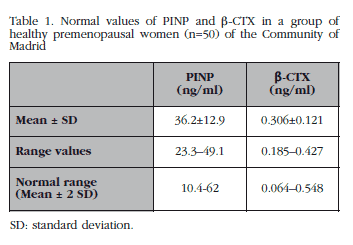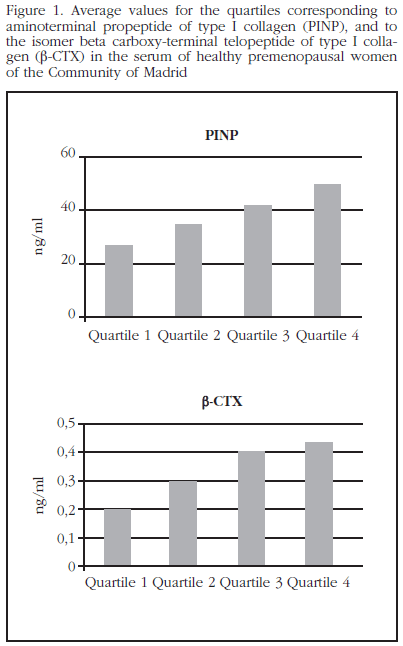Meu SciELO
Serviços Personalizados
Journal
Artigo
Indicadores
-
 Citado por SciELO
Citado por SciELO -
 Acessos
Acessos
Links relacionados
-
 Citado por Google
Citado por Google -
 Similares em
SciELO
Similares em
SciELO -
 Similares em Google
Similares em Google
Compartilhar
Revista de Osteoporosis y Metabolismo Mineral
versão On-line ISSN 2173-2345versão impressa ISSN 1889-836X
Rev Osteoporos Metab Miner vol.6 no.1 Madrid Jan./Mar. 2014
https://dx.doi.org/10.4321/S1889-836X2014000100005
Normal values of the aminoterminal propeptide of type I collagen (PINP) and the isomer beta I collagen carboxyterminal telopeptide (β-CTX) in serum of healthy premenopausal women of the Community of Madrid
Valores de normalidad del propéptido aminoterminal del colágeno tipo I (PINP) y del isómero beta del telopéptido carboxiterminal del colágeno I (β-CTX) en el suero de mujeres sanas premenopáusicas de la Comunidad de Madrid
Rubert M.1, Martínez-Calatrava M.J.2 y de la Piedra C.1
1Bioquímica Investigación
2Laboratorio de Patología Osteoarticular
Instituto de Investigación Sanitaria - Fundación Jiménez Díaz - Madrid
SUMMARY
Introduction: In the laboratory it is sometimes difficult to find the normality intervals of the population itself, there being a tendency to give the normality value specified by the manufacturer of the reagent. The aim of this work was to calculate the normality values for aminoterminal propeptide of type I collagen (PINP) and for the beta isomer of carboxy-terminal telopeptide of type I collagen (β-CTX) in the blood of a group of premenopausal women from the autonomous Community of Madrid.
Materials and methods: The study was carried out in 50 healthy premenopausal women between 27 and 40 years of age (mean ± standard deviation of 34±3 years, working in a hospital and a pharmaceutical laboratory in Madrid.
Blood levels of PINP and β-CTX were determined using the technique of electrochemiluminescence (Elecsys, Roche).
Results: Normal values of 36.2±12.9 ng/ml (range 10.4 to 62) for PINP and 0.306±0.121 ng/ml (range of 0.064 to 0.548) for β-CTX were obtained.
Conclusions: Although the population sample used was small and localised, we consider that these values may be used as the normality interval for Spanish women.
Key words: normality interval, PINP, β-CTX.
RESUMEN
Introducción: En el laboratorio resulta complejo en ocasiones tener intervalos de normalidad de la propia población, y se tiende a mostrar el valor de normalidad indicado por el fabricante del reactivo. El objetivo de este trabajo fue calcular los valores de normalidad del propéptido aminoterminal del colágeno tipo I (PINP) y del isómero beta del telopéptido carboxiterminal del colágeno I (β-CTX) en el suero de un grupo de mujeres sanas premenopáusicas de la Comunidad de Madrid.
Materiales y métodos: El estudio se realizó en 50 mujeres sanas premenopáusicas de entre 27 y 40 años de edad (media ± desviación estándar: 34±3 años), trabajadoras de un hospital y un laboratorio farmacéutico situado en Madrid.
Se determinaron el PINP y el β-CTX en suero mediante una técnica de electroquimioluminiscencia (Elecsys, Roche).
Resultados: Se obtuvieron unos valores normales de 36,2±12,9 ng/ml (rango 10,4-62) para el PINP y de 0,306±0,121 ng/ml (rango de 0,064 a 0,548) para el β-CTX.
Conclusiones: Aunque se trata de una muestra poblacional pequeña y localizada, consideramos que estos valores pudieran utilizarse como intervalo de normalidad para la mujer española.
Palabras clave: intervalo normalidad, PINP, β-CTX.
Introduction
The use of markers for bone remodelling in clinical practice raises the necessity of having appropriate and reliable normal values with which the patient data may be compared. The aim of this work was to calculate the normality values for aminoterminal propeptide of type I collagen (PINP) and for the isomer beta carboxy-terminal telopeptide of type I collagen (β-CTX) in the serum of healthy premenopausal women of the Community of Madrid (Spain).
Materials and methods
The study was carried out in 50 healthy premenopausal women of between 27 and 40 years of age, with the mean ± standard deviation of 34±3 years, staff of the Jiménez DÃaz Foundation Hospital and the offices of a pharmaceutical laboratory in Madrid. All the subjects completed a short questionnaire to discount bone metabolism diseases, hypo- or hyperthyroidism or diabetes, as well as taking a haemogram and basic biochemistry which included thyroid hormones. None of the subjects were taking oral contraceptives. The blood was taken in fasting, at between 8 and 10 in the morning. The blood was centrifuged and the serum separated and immediately frozen aliquots were stored at -80oC for the analysis of bone markers.
The PINP in the serum was determined by the electrochemiluminescence technique using the Elecsys (Roche) automatic method. The sensitivity of the method is 0.01 ng/ml and the inter- and intra-analysis variation coefficients are <1.8% and <4.3% respectively.
The β-CTX in serum was also determined through electrochemiluminescence using the same Elecsys (Roche) method. The sensitivity of the method is 5 ng/ml and the inter- and intra-analysis variation coefficients were <2.1% and <2.4% respectively.
Results
Values (mean ± SD) of 36.2±12.9 ng/ml (range: 23.3-49.1) were obtained for PINP and 0.306±0.121 ng/ml (range: 0.185-0.427) for β-CTX Table 1). Figure 1 shows the values of the quartiles corresponding to each marker.
Discussion
Following the criteria of other researchers such as Richard Eastell, we consider that the normality range for markers for remodelled bone should be that of healthy premenopausal women of between 30 and 45 years of age, who have already reached their peak of bone mass, since although bone remodelling activity increases postmenopause, the aim of antiosteoporotic treatments is to return the patients' remodelling activity to premenopausal levels, and preferably to its first quartile1.
Due to the small differences which may be seen in different geographic areas, it appeared interesting to us to compare the values obtained in our work with earlier studies carried out in Spanish women.
Thus, the values of PINP we obtained are similar to those found by Álvarez et al.2 : average value 33.8 ng/ml in the control group of healthy postmenopausal women, although using a different method (radioimmunoanalysis - RIA of Orion Diagnostica). Using the same technique, Peris et al.3 reported values of PINP in serum of 30±11 ng/ml in a group of healthy premenopausal women. As can be seen, the values found using RIA are slightly lower than those obtained by electrochemiluminescence in our work: 36.2±12.9 ng/ml.
As was expected, the values found in a group of healthy postmenopausal women are higher than those for premenopausal women, since bone remodelling accelerates in the postmenopausal state. Thus, Martínez et al.4 reported average values of 47.7±19.9 ng/ml in a group of 1,080 healthy postmenopausal women, and Schoppen et al.5 found average values of 40.9±12.6 ng/ml in a Group of 18 women who were also healthy and postmenopausal.
With respect to levels of β-CTX, our values are similar to those found by Kanterewick et al.6 in a population of 34 premenopausal women: 0.305±0.150 ng/ml, obtained using the same method used in our study (Elecsys, Roche). Martínez et al.4, in the aforementioned work found levels (0.387±0.197 ng/ml) higher than ours in a group of 1,080 healthy postmenopausal women, and it was the same case with values obtained by Schoppen et al.5: 0.47±0.14 ng/ml in the group of 18 healthy postmenopausal women.
Conclusions
Given the similarity to those found by other authors in our country, we consider that the values of PINP and β-CTX (36.2±12.9 ng/ml and 0.306±0.121 ng/ml, respectively) obtained in this work may be safely used as normality values for these markers for bone remodelling in Spanish women.
![]() Correspondence:
Correspondence:
Concepción de la Piedra
Laboratorio de Bioquímica
Fundación Jiménez Díaz
Avda. Reyes Católicos, 2
28040 Madrid (España)
Correo electrónico: cpiedra@fjd.es
Date of receipt: 17/10/2013
Date of acceptance: 21/01/2014
Bibliography
1. Eastell R, Barton J, Hannon RA, Chines A, Garnero P, Delmas PD. Relationship in early changes in bone resorption to the reduction in fracture risk with risedronate. J Bone Miner Res 2003;18:1051-6. [ Links ]
2. Álvarez L, Ricos C, Peris P, Guañabens N, Monegal A, Pons F, et al. Components of biological variation of biochemical markers of bone turnover in Paget's bone disease. Bone 2000;26:571-6. [ Links ]
3. Peris P, Álvarez L, Monegal A, Guañabens N, Durán M, Pons F, et al. Biochemical markers of bone turnover after surgical menopause and hormone replacement therapy. Bone 1999;25:349-53. [ Links ]
4. Martínez J, Olmos JM, Hernández JL, Pinedo G, Llorca J, Obregón E, et al. Bone turnover markers in Spanish postmenopausal women: the Camargo cohort study. Clin Chim Acta 2009;409:70-4. [ Links ]
5. Schoppen S, Pérez-Granados AM, Carbajal A, de la Piedra C, Pilar Vaquero M. Bone remodelling is not affected by consumption of a sodium-rich carbonated mineral water in healthy postmenopausal women. Br J Nutr 2005;93:339-44. [ Links ]
6. Kanterewicz E, Peris P, Puigoriol E, Yáñez A, Rosique P, del Rio L. FRODOS Research Group. Distribution of serum BCTX in a population-based study of postmenopausal women taking into account different anti-osteoporotic therapies (the FRODOS Cohort). J Bone Miner Metab 2013;31:231-9. [ Links ]











 texto em
texto em 




